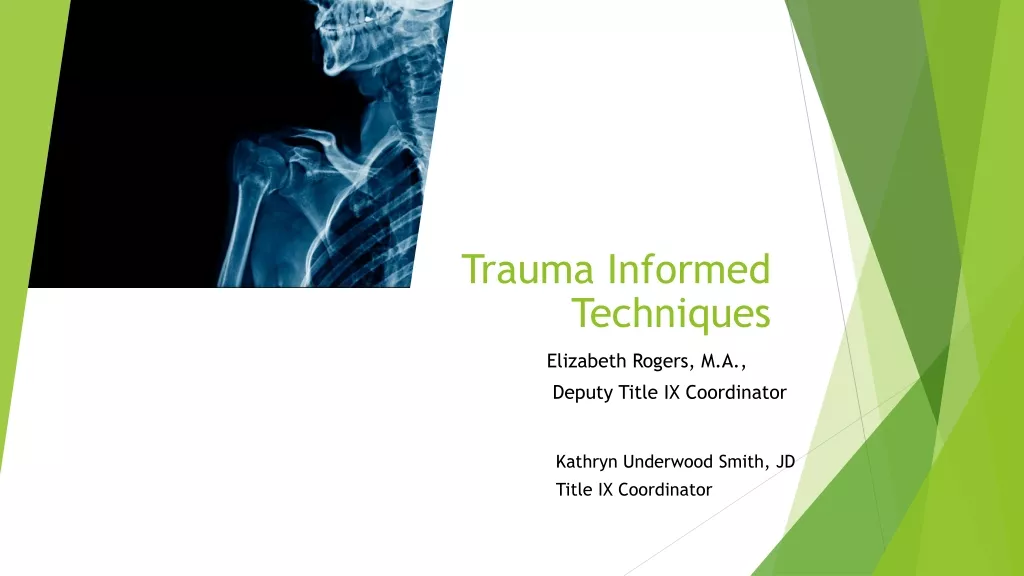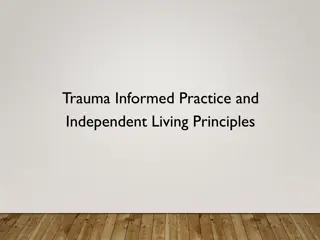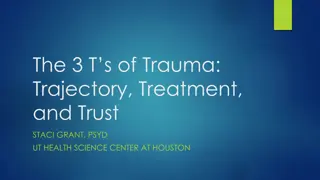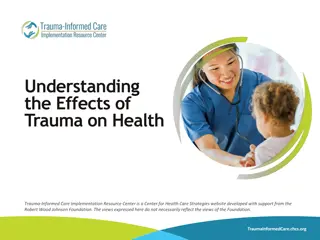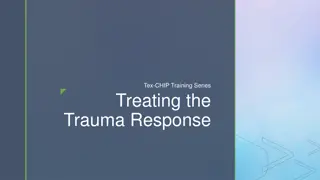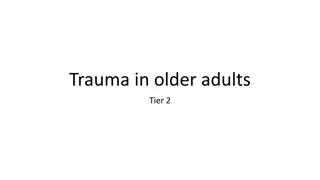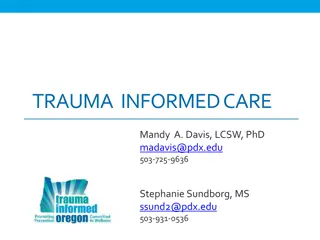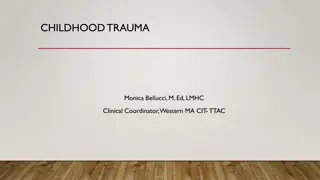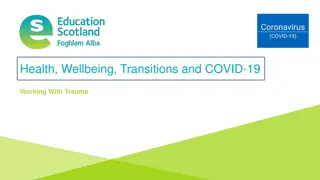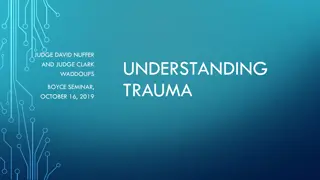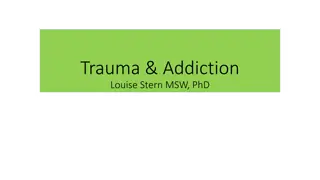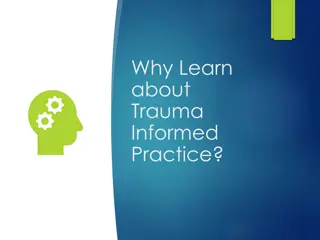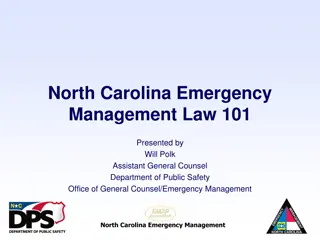Overview of Trauma Management in the Emergency Department
This summary file covers the key aspects of trauma management, including epidemiology of trauma, mechanisms of injury (penetrating and blunt), triage and severity scoring, primary survey with ABCDE approach, emergency department management per ATLS protocol, and adjuncts to primary survey. It emphasizes the importance of quick assessment, airway protection, breathing support, circulation management, neurologic evaluation, and environmental considerations in the initial management of trauma cases.
Download Presentation

Please find below an Image/Link to download the presentation.
The content on the website is provided AS IS for your information and personal use only. It may not be sold, licensed, or shared on other websites without obtaining consent from the author.If you encounter any issues during the download, it is possible that the publisher has removed the file from their server.
You are allowed to download the files provided on this website for personal or commercial use, subject to the condition that they are used lawfully. All files are the property of their respective owners.
The content on the website is provided AS IS for your information and personal use only. It may not be sold, licensed, or shared on other websites without obtaining consent from the author.
E N D
Presentation Transcript
Summary File Team leaders: Nouf Alshammari Naif Alsulais Haneen Somily Mohammed alshoieer This File was done by: Naif Alsulais Mohammed Musfer Mashal AbaAlkhail Mohammed alshoieer Noura Alturki Ateen Almutairi Wejdan Alnufaie Lama Alassiri Deema Almaziad Fatemah Alsaleh Shahad BinSelayem Razan AlRabah Nouf Alshammari Taif Alshammari Njoud Alali Jude Alkhalifah Nujud Alabdullatif Ajeed Alrashoud Editing File Summarized the lectures
Trauma: Obj1: Mention the epidemiology of trauma Leading cause of death up to the age of 45 4th leading cause of death overall for all ages Leading causes of death & disability in Saudi Arabia Obj2: Discuss the mechanism of trauma (Penetrating, Blunt) Blunt injury: Motor Vehicle Collisions (MVC) Fall from height: adult = 6m, kids = 3m Penetrating injury: High velocity (gun shot) Low velocity (stabbing) Obj3: Discuss the triage and scoring for severity in trauma cases. Anatomical: AIS:The most commonly used system ISS:summing the squares of the AIS Minor = <9 Ex: injured face, neck and thorax. AIS : face = 2, neck = 3, thorax = 4 ISS : (4)+(9)+(16) = 29 = severe Physiological: GCS: The best known physiological scoring system assess the ability to open eyes + verbal response + motor responses The highest score is 15 (normal) and the lowest score is 3 (deep coma or death). GCS = 8 or less is considered to be in coma and must be intubated RTS: GCS + SBP + RR. Moderate 9-15 Serious 16-24 Severe = >25 Obj5: Describe the emergency department management per ATLS protocol Injury > primary survey > resuscitation > reevaluation > secondary survey > reevaluation > optimize > transfer. What s the objective of prehospital care? prevent further injury, initiate resuscitation and transport the patient safely and rapidly to the most appropriate hospital.
Trauma: Obj6: Discuss the primary survey (diagnosis of the problems and immediate management) 1- Precautions (PPE): Cap, Gown, Gloves, Mask ... 2- Quick assessment:simple Q, the answer confirms ABCD > A: airway B: breath C: circulation D: no disability 3- ABCDE:- Airway: protect c-spine with a collar and establish patent air by: Basic airway technique: 1-chin-lift maneuver (no head tilt) 2-jaw-thrust maneuver (better) if not breathing then advanced airway technique: Orotracheal intubation, failure or extensive facial injuries? Cricothyroidotomy. Extensive laryngeal injury? Tracheostomy. Changed mental status > most common cause of airway obstruction > the most common indication for intubation Breathing: adequate oxygenation and ventilation by RR, chest movement, air entry, O2 saturation (must be >90) Immediate life threatening injuries: 1- Laryngotracheal injury / Airway obstruction 2- open pneumothorax = initial: 3 sided occlusive dressing, definitive: chest tube 3-Massive hemothorax = Chest tube drainage pericardiocentesis 4- Tension pneumothorax = Needle thoracocentesis 5-Flail chest and pulmonary contusion 6-Cardiac tamponade = needle Circulation: Level of consciousness, Skin color and temperature, Pulse rate and character Management: Control hemorrhage, Restore volume Reassess patient, direct pressure, Lethal triad (Acidosis, Hypothermia & Coagulopathy) Disability: GCS (look at the pic) and pupillary response Exposure / Environment: undress patient, prevent hypothermia and don t miss injuries 4- Resuscitation: protect airway, O2, stop bleeding... Special consideration: pregnant = rest on left side, elderly and pediatric = altered physiological signs. Obj7: Recognize the adjuncts to primary survey 1- ECG 2-Vital signs 3-ABGs 4-Urinary Output 5-Urinary/gastric catheter 6-Pulse oximeter and CO2 7-Imaging studies: Chest X-Ray and Pelvic X-Ray. Diagnostic tools: FAST and DPL Obj8: Discuss the secondary survey Start after doing primary survey and Vital functions are returning to normal Secondary survey: History > Physical exam Head to toe > Complete neurologic exam > diagnostic tests> Reevaluation
Shock: Obj1: Define shock Inadequate oxygen delivery to meet metabolic demand results in global tissue hypoperfusion and metabolic acidosis can occur with a normal blood pressure Obj2: : List the types and clinical features of shock Hypovolemic: blood pump is working with no blood, most common and most readily corrected (surgical patient). Losing blood or plasma (burn) or water and electrolytes (dehydration) clinical features: Hypotension, tachycardia, cold clammy skin then dry. Cardiogenic: caused by Impaired inflow, primary pump dysfunction and Impaired outflow. clinical features: Hypotension, tachycardia, cold clammy skin Neurogenic: Loss of sympathetic tone > hypotension and heart won t compensate (no sympathetic alert) typically occurs following injury to the spinal cord. Rare, trauma in head? Think of hypovolemic shock caused by hemorrhage FIRST. Clinical features: Hypotension, bradycardia, warm and dry skin (anhydrosis) Vasogenic:septic: Bacteria > toxins > cell damage > release of cell mediators > uncontrolled vasodilation and leakage Anaphylactic: Allergic reaction resulting in the the release of histamine which causes vasodilation and shortness of breath clinical features: Hypotension, tachycardia, warm skin and febrile in septic Very important to memorize Obj3: : Define the terminology distributive and obstructive shock Distributive: abnormal distribution of blood flow in the smallest blood vessels results in inadequate supply of blood to the body's tissues and organs. Obstructive: type of cardiogenic shock where the problem is outside the heart obstructing it. eg: tension pneumothorax, pulmonary embolism, and cardiac tamponade. Obj4: : Discuss the Pathophysiology of shock (Macrocirculation, Microcirculation, Cellular function) macrocirculation: in hypovolemic there is fall in intravascular volume > fall cardiac output > increase contractility and vasoconstriction. In septic shock circulating proinflammatory cytokines leads to smooth muscle relaxation, vasodilatation and a fall in SVR. In neurogenic loss of cardiac accelerator fibres and anhydrosis as a result of loss of sweat gland innervation. In cardiogenic shock circulating volume is typically normal or increased (AT-II and aldosterone). microcirculation: complications of shock override compensatory vasoconstriction > pooling of blood within the capillary bed and endothelial cell damage > loss of fluid into interstitial spaces > increase in blood viscosity formation of microthrombi. Cellular function: shifting of aerobic glycolysis to anaerobic glycolysis > metabolic acidosis. sepsis is associated with significant mitochondrial dysfunction and marked inhibition of oxidative phosphorylation (cytopathic shock) Obj6: : Discuss the general principles of management (airway, breathing and circulation) discussed in details in trauma lecture
Shock: Obj5: : Discuss the Systemic effects of shock CVS: ischaemia, Acid base and electrolyte abnormalities. in sepsis inflammatory mediators depress myocardial contractility and DIC. Nervous: anxiousness Respiratory: Tachypnoea driven by pain, pyrexia, reduced arterial PCO2 and a respiratory alkalosis (compensating for the metabolic acidosis). Septic and hypovolemic shock could cause RDS Renal: acute tubular necrosis, renal failure occurs in about 30 50% of patients with septic shock GIT: stress ulceration and haemorrhage, SIRS and multiple organ failure Hepatobiliary: ischaemic hepatic injury, Increases in prothrombin time and/or hypoglycaemia are markers of more severe injury Obj7: : Discuss the Specific treatment of each type of shock Hypovolemic Shock: ABCs > Control any bleeding > establish 2 large bore (14 or 16 gauge) better than central line > crystalloids > PRBCs preferred in hemorrhage (O negative or cross matched) > definitive treatment, Then evaluate: Septic shock: obtain blood culture > broad spectrum antibiotic > resuscitate > Hypotension persist? Vasopressors Anaphylactic shock: clinical signs of anaphylactic reaction (the hallmark airway compromise) > ABCs > oxygen > epinephrine > IV fluid > second line (corticosteroids and antihistamine) Cardiogenic Shock: based upon the identification and treatment of reversible causes then supportive: administration of high concentrations of inspired oxygenation > IV opiates (MI patient) > correction of hypovolaemia (not in HF patient) not responding? dobutamine > Neurogenic Shock: IV fluid resuscitation > hypotension persist? Vasopressors How to know resuscitation is enough? 1-Normal vital signs 2-Normal serum lactate levels 3-Evidence of adequate tissue perfusion (normal mental status, normal urine output (best marker) and normal liver function Keep Going
Burn: Obj1: Define burn. Destruction of tissues caused by various etiologies including flames, and hot liquids, that ranges from trivial to life threatening which requires extensive treatment and rehabilitation with the chances of permanent dysfunction and distortion. Obj2: Discuss the incidence of burn. 2 million burns per year in the US. Mortality is highest in the age groups: 2-4 years & 17-25 years. 500K burns treated in the ER. 70K burn hospital admissions. Obj3: Discuss the pathophysiology of burn local effects > inflammatory response > capillary dilation (erythema) or capillary damage (edema) > if 15% of body surface burned = severe hypovolemia = hypovolemic shock. Destruction of the Epidermis impair physical barriers and predispose to infections: most common organisms = staph, strept and pseudomonas (sepsis) Burns have 3 zones : 1-Zone of coagulations 2-Zone of stasis (the area of potential reversible cell damage) 3-Zone of hyperemia. Obj4: Recognize the calculation Rule of nine: Palm without fingers = 1% Head in kids = 18% (9% in adults) Single leg in kids = 9% (18% in adults) Mortality: (body surface area% + age)/100 Parkland formula: administration during the first 24 hours = 4mL weight (kg) TBSA% 50% given in the first 8 hours 50% given in the next 16 hours When to transfer to a burn center (transfer criteria)? >25% body surface area (BSA). >20% BSA in children. High voltage burns, Inhalation injuries and chemical burns. Burns in the genital area, face, neck, feet and hands in addition to full thickness burns. Obj5: List the types of burn Based on depth:- First degree: involves epidermis only (edema and erythema) Second degree: superficial: epidermis and part of dermis (papillary), deep: epidermis and dermis (reticular) (blisters). Third degree: involves Entire dermal layer and subdermal fat (dry, inelastic and waxy scar) Fourth degree: all skin layers + bones, muscles and tendons In clinical practice, most burns are a mix of types. Any burn is surrounded by lighter zones eg: 2nd degree burns are surrounded by 1st degree burns and 3rd degree burns are surrounded by an engorge erythematous area (2nd degree burns). First site to come in contact with the burning agent is the deepest site of the burn. Retainment of sensations at the site of the burn suggest more superficial injury. Based on agent:- Thermal Chemical
Burn: Obj6: Explain the inhalation injury Usually fatal caused by inhalation of smoke from burning objects eg:plastic. Carbon monoxide displaces oxygen and binds to hemoglobin forming (Carboxyhemoglobin) Cyanide inhalation is also common and can be fatal Damage to lung parenchyma can happen, patient can be saved if he was put on 100% O2 Obj1: Explain the chemical Burn chemical agents react with the body s tissue and the injury extends deeper it doesn t just end with removing the agent Acid: the most common and causes necrosis Base: the most dangerous Factors worsen: Area of contact, PH & concentration, form of agent, duration, amount. Obj1: Explain the electrical Burn burning from inside out from deeper organs, patients who experience electric shock may have no external injuries. Severity depends upon: Voltage, Amperage, Resistance, Type of current, Duration Low voltage is the worse and it follows the least resistance organs. High voltage direct flow Systemic injury: Cardiac arrhythmias, sepsis, Renal failure (Due to muscle necrosis), PNS injury Cause compartment syndrome (details in arterial lecture) Obj1: Discuss the burn management Objective of treatment: 1-prevent edema 2-prevent contractures 3- prevent infection 4-preserve viable tissue First degree: Mild analgesics/NSAIDs (nerve endings intact), daily cleansing and flamazine Second degree: same 1st degree and leave blisters intact, if debrided? Occlusive dressing. Third degree: surgically debride and remove the eschar then skin graft Fourth degree: skin graft not adequate. Amputation or flap coverage. Wound closure: in deep second degree when burn didn t heal after 2 weeks Chemical: as GP dilute it with water to minimize its effect The solution of pollution is dilution Electrical: Fasciotomy (compartment syndrome), Debridement of dead tissue, definitive: Amputation or flap coverage Prophylaxis against Tetanus Surgical:- Escharotomy: incision through the eschar, most important indication is circumferential burn (which causes hypoperfusion due to edema). Grafting: removing skin from one area of the body and transplanting it to a different area of the body. Flap: using bulky tissue (e.g. muscle flap, subcutaneous tissue flap) has its own supply used when there s a deep burn (4th degree burns). Obj1: Identify the complications of burn early consequences: Hypovolemic shock, Electrolytes imbalance, Sepsis, Hemolysis and Hypothermia. Short term consequences: Nutritional depletion, Respiratory failure, Renal failure, Venous thrombosis and Curling s ulcer Long term consequences: Permanent disfigurement, Prolonged hospitalization, Psychological disturbance
Wound Healing: Obj1: Define the wounds Wound: disruption of normal anatomical structure and function can be chronic and acute. Classified into Incised wounds (sharp instrument), Abrasions, Degloving, Crush, burn and gunshot. Obj2: Discuss the phases of wound healing 1-Heamostasis (5-10min): Main cells are: platelets: form the platelet plug, degranulation of platelets and recruitment of neutrophils stimulated to release: platelet derived growth factor (PDGF) transforming growth factor (TGF ): has a major role in wound healing (Excess causes abnormal scars) produced by granules fibroblast growth factor 2-Inflammatory/Migratory lag phase1 (1-4 Days): presented by rubor, tumour, calour and dolour Main cells: Main cells are: first 24 hours PMNs (neutrophils) After 24 hours Macrophages: Phagocytosis, wound debridement, activation of fibroblast, angiogenesis and matrix synthesis regulation 3-Proliferative/Fibroplasia incremental (3 days - 3 weeks): Main cells are: Fibroblasts Re-Epithelization, angiogenesis, collagen synthesis and ECM formation 4-Remodeling /Maturation (3 weeks-one year): Type III collagen replaced by type I collagen and become organized and the scar became mature. re-establishing normal 4:1 ration (I:III): Duration depends on age, genetics, type of wound, location. Tensile strength increases. Obj3: List the types of wound healing By types: Primary: horizontal repair generate fine scar Delayed Primary: we wait for 2-4 days then primary healing Secondary: horizontal and vertical repair (edges far from each others) partial-thickness: vertical repair (dermis not involved) By timing: Acute: 1st week Subacute:1-6 weeks Chronic: > 6 weeks By abnormal healing: Overgrowth: Hypertrophic and Keloid Undergrowth: pressure sore and diabetic wounds Abnormal pigmentation Contour abnormality Wound closure: 1 intention: Primary closure by suturing the edges together. 2 intention: Wound left open to heal by processes of granulation contraction and epithelialization 3 intention: delayed primary healing (a combination of primary healing and secondary healing). Desired for contaminated wounds Horizontal repair: by contraction (edge to edge proximation) Vertical repair: by epithelializatiion
Wound Healing: Obj4: Recognize the factors affecting wound healing General (patient): Local (wound): 1. 2. 3. 4. 5. 6. 7. 8. 9. 10. 11. Nutrition Drugs/Toxins Age DM Smoking Vascular disease Obesity Systemic diseases Idiopathic Inherited diseases Surgical technique 1. 2. 3. 4. 5. 6. 7. 8. 9. 10. Oxygen Infection Acidity Radiation Loss of growth factors Denervation (in diabetics) Iatrogenic Edema Cancer Foreign body Obj5: identify the abnormal wound healing Ideal scar:flat narrow, good color, parallel to RSTL, doesn't restrict function, asymptomatic and mature in 6-18 months Features Hypertrophic scar Keloid scar Abnormal scars: Keloid scar: excision can be done as an alternative Hypertrophic scars: these scars should not be excised Wide scar: Caused by traumatic wounds that are not closed properly Genetic Not familial May be familial Race Not race related Black > White Sex Female = Male Female > Male Treatment : Prevention Medical: steroids (first line), chemotherapy (5-FU) or radiation Non surgical: pressure, silicone gels or sheets Surgical: laser or surgery If failed in keloids the best treatment approach is a combination of intralesional excision followed immediately by low-dose radiotherapy Age Children 10-30 years Borders Remains within wound Outgrows wound area Natural history Subsides with time Rarely subsides Site Flexor surfaces Sternum, shoulder, face Aetiology Related to tension Unknown Not included in objectives but important! Classification of contamination in Surgical wounds Clean: nontraumatic, non infected wounds & no breach of Resp, GI, or GU tract. thyroid and breast surgeries. (No need for antibiotics) Clean-contaminated: Small breach in protocol; Resp/GI/GU tract are entered with minimal contamination. cholecystectomy, uncomplicated appendicitis, intestinal resection ONLY if there was no spillage. Contaminated : Fresh traumatic wounds; major break in sterile technique, nonpurulent inflammation; in or near contaminated skin. hemicolectomy or resection of the intestine with spillage Infected: Purulent infection. traumatic open bone fracture, and purulent pyogenic perforated appendicitis. Collagen: Lysine and proline hydroxylation required for cross linkage (the main step in collagen synthesis) the rule of Vit.C Normal skin ratio - Type I:Type III = 4:1, Hypertrophic / immature scar 2:1 ratio Formation inhibited by: Colchicine, penicillamine, steroid, Vit.C deficiency and Fe deficiency. (They activate collagenase which degrades collagen synthesis and inhibits cross linkage hydroxylation of lysine and proline)
Metabolic response to injury: Obj1: Factors mediating the metabolic response. Our aim is to blunt EBB phase as it will lead to further tissue damage and supplement patients in Flow phase to assure healing and prevent complications Response Cellular activation. Inflammatory mediators (TNF, IL1,IL2, IL3, IL4 and IL6). Paracrine vs endocrine effects. Acute Inflammatory Response Ebb phase Flow phase VS Cardiac output Oxygen consumption Blood pressure Tissue perfusion Body temperature Metabolic rate Catecholamines Glucocorticoids Glucagon Release of cytokines, lipid mediators Acute phase protection production Selectins, Integrins and ICAMs. Nitric Oxide > vasodilation > edema. Tissue Factor > coagulation > DIC. Endothelium Sympathetic nervous system activation. Release of hormones from adrenal medulla. Stimulation of other pituitary hormones. Afferent nerve stimulation More stress hormones, less anabolic hormones: Pituitary gland: GH, ACTH and ADH. Adrenal: cortisol, aldosterone. Pancreas : glucagon, Insulin. Other: renin, angiotensssion, sex hormone, T4. Obj2: Consequences of the metabolic response. The metabolic response limits the injury and initiate the repair process by mobilizing substrates. Help in preventing the infections but could cause distance organ damage. More consequences: Endocrine system Hypovolemia: characterises moderate to severe injury Energy expenditure:rises up to 50% due to 1-thermogenesis: 1C increases BMR by 10% 2-increased BMR Catabolism: hypoglycemia, breakdown of triglycerides into glycerol and FFAs, Breakdown of skeletal muscles into amino acids Starvation: acute phase: glycogenolysis and gluconeogenesis in liver releasing glucose for brain, Lipolysis and FFAs release. Chronic phase: initially muscle catabolism to convert amino acids into glucose and FFAs into ketones (mainly) then when fat stores depleted muscles are used again as final energy source RBCs synthesis and coagulation: 1-anemia: when Hgb <8 transfusion indicated. 2-hyperhypercoagulability and may develop DIC. anabolism: when the response stops body will regain wight and skeletal muscle. Hormones contributing: Insulin, GH, androgens and IGF Obj3: The differences between metabolic responses to starvation and trauma. Starvation Trauma or Disease Metabolic response to starvation Metabolic Rate Hormone Source Change in Secretion Body Fuels Conserved Wasted Norepinephrine Sympathetic Nervous System Body Proteins Conserved Wasted Norepinephrine Adrenal Gland Urinary Nitrogen Epinephrine Adrenal Gland Thyroid Gland (changes to T3 peripherally) Thyroid Hormone T4 Weight Loss Slow Rapid Obj4: The effect of trauma on metabolic rate and substrate utilization. Obj5: Modifying the metabolic response
Transfusion Medicine & Therapy Massive blood transfusion? Unit of blood in 24h Obj1: Describe the blood donation Whole blood is donated by healthy adult volunteers over the age of 17 years with normal hemoglobin levels. The standard 480 mL donation contains approximately 200 mg of iron Apheresis: method by which red cells are separated from the blood at the time of collection. Storage: Refrigerated at 4 C, changes to the blood include in pH, in 2,3-DPG, deformability of RBCs and Hyperkalemia Obj2: Discuss the blood components 1- Packed RBCs (PRBC): Run through a leucodepletion filter to reduce the white cells to a very low concentration. The final product has a hematocrit of 55 65% and a volume of approximately 300 mL (1U) which increases the Hgb by about 1 g/dL or the hematocrit by about 3% indicated for acute blood loss, anemia, patient who receives chemotherapy. Patient with ongoing hemorrhage, or healthy patient with Hgb < 6 g/dL <6 : always needs the transfusion 6-10 : needs clinical judgement <10 : needed in patient with IHD >10 : give IV fluid 2-Platelets: it should ideally be ABO- and RhD-compatible with the recipient, the dose 6 packs in adult and 1U/kg in children. An adult dose should raise an adult platelet count by 20 40 billion per liter. RDP: random donor platelets made from 4-6 separate donations SDP: single donor platelets (from one donor using apheresis) Indicated in: thrombocytopenia, defective platelets function and in patients receiving massive blood transfusions when there is microvascular bleeding 3-Fresh Frozen Plasma (FFP): 30% of plasma factor concentration. must be ABO compatible and given within 2 to 6 hours of thawing (too cold stored in -30 C) Indicated in: multiple coagulation factor deficiencies, can be used in blood loss cases if needed. 4-Cryoprecipitate: source of fibrinogen, factor VIII, and von willebrand factor (vWF) Indicated in: dysfunctional (type II) or absent (type III) von willebrand disease, when factor VIII con Concentrate of platelets3 Red blood cells Fresh Frozen plasma2 cryoprecipitate To correct deficiency in coagulation factors or to treat shock due to plasma loss from burns or massive bleeding To treat or prevent bleeding due to low platelet levels. To correct platelet problems. To increase the amount of red blood cells after trauma or surgery or to treat severe anemia. To treat fibrinogen deficiencies Indicated Storage period 42 days in the refrigerator or 10 years in the freezer1 5 days at room temperature 1 year in the freezer 1 year in the freezer
Transfusion Medicine & Therapy Obj3: Discuss the plasma products Albumin: Indicated in hypoproteinemia & burns. Factor VIII & factor IX concentrates: used in haemophilia Prothrombin Complex concentrates: contain factors II, IX, X, and VII Indicated in prophylaxis & treatment of bleeding. Immunoglobulins Preparations (90% IgG): Prepared from individuals known to have high levels of specific antibodies, Indicated in hyperimmune globulin against hepatitis B, herpes zoster, tetanus and RhD. Obj4: Discuss the red cell serology The absence of an antigen induces an antibody, basically if your blood type is O you have both anti A and B so if you receive RBC has A or B antigen will be destroyed. We are not afraid from donor s antibodies (it will be removed while processing). Many different blood group antigens exist against which antibodies can be formed of varying clinical significance, could cause intra- or extravascular hemolysis. The most important of these are those of the Kell, Kidd and Duffy systems. A+ A- B+ B- AB+2 AB- O+ O-3 Abs in Plasma Anti-B Anti-A None Anti-B & Anti-A Antigens in RBC A antigen B antigen A & B antigens None A+ & AB+ A-, AB-, A+ & AB+ O+, A+, B+, & AB+ All blood types Can donate to B+ & AB+ B-, AB-, B+, & AB+ AB+ AB-, & AB+ Can receive A+, A-, O+, & O- A- & O- B+, B-, O+, & O- B-, & O- All blood types AB-, A-, B-, & O- O+ & O- O- the second most common(1 in 3 = 34%) isn t very common (1 in 16 = 6.3%) the most common (1 in 3 = 39%) 1 in 29 = 3.5% 1 in 15 = 6.6% Percentage 1 in 12 = 8.5% 1 in 67 = 1.5% 1 in 167 = 1% Obj5: Identify the pre-transfusion testing Blood grouping: determining the patient s ABO and RhD type by: Forward typing: by using antiserum (from lab) directed against the A, B and D antigens. (What we did in physiology lab) Reverse typing: the opposite, we use blood RBCs (from lab) and direct the donor s antiserum against. Rh typing: adding a commercial reagent (anti-D) to recipient RBCs. Antibody screen:use of a panel of cells to screen a sample of the patient s serum for the presence of clinically significant antibodies. about 2% of population have antibodies targeted against RBCs that are non(ABO/Rh) antibodies. Cross-Matching: checking the compatibility of the donor units with the patient s serum. Done just before the transfusion and has 3 forms... Obj6: Recognize the indications for transfusion Why to transfuse blood? Increase oxygen carrying capacity, restoration of red cell mass, correction of anemia and bleeding. Oxygen Delivery (DO2) is the oxygen that is delivered to the tissues. Clinical judgment: Hgb concentration is not enough to take the transfusion decision, we must consider: determinant factor: age, weight, severity of symptoms, cause of the deficit, underlying medical condition and ability to compensate. clinical evaluation: apperance, mentation, HR, BP, nature of bleeding. laboratory evaluation: Hgb, hematocrit, platelets, clotting function, electrolytes. DO2= CO x CaO2 Cardiac Output (CO): HR x SV Oxygen Content (CaO2): (Hgb x 1.39)2x O2 Saturation + (PaO2 x 0.003)3 Hgb is the main determinant of oxygen content in the blood Therefore: DO2 = HR x SV x CaO2 If HR or SV are unable to compensate, Hgb is the major determinant factor in O2delivery.
Transfusion Medicine & Therapy Obj7: Discuss the blood administration Two qualified personnel check it at the bedside, check Recipient (ID or MRN) and unit identification, confirmation of compatibility, expiration date Anesthesiologist responsible for transfusing perioperatively Urgent transfusion: using pressure bag and large-bore needle, If only a small-gauge needle is available the transfusion may be diluted with normal saline Obj8: Identify the adverse effects of transfusion Immune mediated reactions Acute Hemolytic Transfusion reactions: Immune-mediated hemolysis mainly due to the ABO isoagglutinins (incompatibility) Symptoms: Hypotension, tachypnea, tachycardia, fever, chills, hemoglobinemia, hemoglobinuria, chest/flank pain and discomfort at the infusion site. Lab: low serum haptoglobin, high lactate dehydrogenase (LDH) and high Indirect bilirubin levels Management: stop transfusion and report blood bank, Diuresis IV (renal failure) and monitor for DIC Febrile nonhemolytic transfusion reaction (FNHTR): The most frequent reaction characterized by chills and rigors Allergic Mild reactions related to plasma proteins found in transfused components, treated symptomatically by temporarily stopping the transfusion until the symptoms resolve and administering antihistamines Anaphylactic results from previous transfusion and exposure to the antigens causing the antibodies formation, and in the second exposure anaphylaxis occur. Symptoms: Difficulty in breathing, Coughing, Nausea and vomiting, Hypotension, Bronchospasm, Loss of consciousness, Respiratory arrest and Shock. Management: stop transfusion and administering epinephrine. Graft-versus-host-disease: rare, frequent complication of allogeneic stem cell transplantation. Symptoms: Fever, cutaneous eruption and Diarrhea. Lab: LVT Transfusion-related acute lung injury: As result of receiving More than 10-20 units Symptoms: acute respiratory distress, hypoxia and signs of noncardiogenic pulmonary edema Management: supportive Non-immune mediated reactions Fluid overload: Monitoring the rate and volume of the transfusion and using a diuretic can minimize this problem. Hypothermia: Cardiac dysrhythmias can result from exposing the sinoatrial node to cold fluid, Use of an in-line warmer Electrolyte toxicity: Hypocalcemia, may result from multiple rapid transfusions Iron overload: Common after 100 units of RBCs. affects endocrine, hepatic, and cardiac function. Can be prevented by using alternative therapies (e.g., erythropoietin) and by using chelating agents, such as deferoxamine and deferasirox Infections Viral: Hepatitis C & B, Cytomegalovirus, HIV Type 1, Parvovirus B-19, HTLV and West Nile virus Parasite: Malaria, chagas disease (Trypanosoma cruzi) and Babesiosis Bacterial: syphilis Obj9: Describe the autologous transfusion: Donor and recipient is the same person, there are three main autologous programs exist: Preoperative donation: blood is taken and stored in advance of planned surgery and used as required Isovolaemic haemodilution: blood is taken just before surgery and replaced with fluid and then returned unmanipulated immediately after the operation Cell salvage: blood is collected from the operative field and replaced during or immediately after the surgical procedure Obj10: Recognize the methods to reduce the need for blood transfusion Acute volume replacement: Non-plasma colloid volume expanders of large molecules, such as dextran, are first- line management in volume depletion as a result of bleeding. In surgery: Preoperative: by making sure patient has a normal haemoglobin. Intraoperative: the skill and experience of the surgeon to minimize blood loss. Postoperative: Postoperative cell salvage and the Appropriate use of antifibrinolytic drugs such as tranexamic acid (used in major hemorrhages)
Approach to common Thoracic & Lung Diseases: Agenesis No development / complete absence of the lungs. Hypoplasia Incomplete development of the lung. Cystic adenomatoid malformation: overgrowth of abnormal lung tissue that may form fluid-filled cyst Presentation: Pediatric patients with: Pneumothorax Repetitive chest infections Fever CXR abnormalities Treatment: surgery remove that part Lobar emphysema Entire lobe replaced with a big cyst or emphysematous bullae (usually the right lobe) Presentation: newborn unable to breath +ve pressure mechanical ventilation (long-term) affects nearby organs Treatment: lobectomy Pulmonary sequestration non-functional mass of normal lung tissue that lacks normal communication with the airways, can be intra or extra lobular (most common left lower lobe), Receives its own supply from the systemic circulation (most common thoracic aorta) Presentation: Repetitive chest infection Mass on CXR or CT-scan (usually left lower lobe) Treatment: CT-scan with contrast and tie the arterial supply (usually from thoracic aorta) then remove the sequestration. Bronchogenic cyst: benign cyst with malignant position (Right para-tracheal most common & subcarinal) Presentation: dysphagia, stridor Complications: Infections, hemorrhage, transformation to adenocarcinoma Treatment: CT then surgical removal by thoracoscopy, If SVC is involved thoracotomy Lung abscess: Etiology: Immunocompromised (Diabetic, HIV) Pneumonia Bronchial obstruction Presentation: Large amount of foul-smelling sputum Productive cough +/- hemoptysis Septic or toxic high fever & chills Severe chest pain Dyspnea Investigation: CXR (air-fluid level abscess) CT-scan Treatment: Concerted: Antibiotic + Drainage (Pigtail catheter) Surgery: Lobectomy, Segmentectomy, Pneumonectomy. Indication for surgery: Failure of Tx / Giant abscess >5 cm / Hemorrhage / can t r/o carcinoma / rupture with resulting empyema.
Approach to common Thoracic & Lung Diseases: Bronchiectasis Etiology: Untreated pneumonia Obstruction by foreign body. Cystic fibrosis Immotile cilia syndrome Types: Cystic (surgically corrected) Cylindrical (not surgically treated, Cystic fibrosis, immotile cilia syndrome) Presentation: Productive morning cough Dyspnea Investigations: CXR CT (confirmation) Treatment: Medical:for bilateral conditions (Abx, Supportive, Postural drainage) Surgery indication: Failure of medical Tx Localized disease Tuberculosis Etiology: Pulmonary TB empyema TB lymphadenitis Presentation: Fever Night sweats Investigation: CXR CT (confirmation) Treatment: Medical:1st & 2nd lines of anti-TB. Surgery indications: Failure of medical Tx Destroyed lobe or lung Hemorrhage Aspergillosis according to amboss it doesn t usually cause infection in immunocompetent patients. Etiology: Aspergillus fumigatus Aspergillus niger. Forms: 8 forms Allergic bronchopulmonary aspergillosis Saprophytic Presentation: Aspergilloma (cavity ball-like on CT) Chronic productive cough Hemoptysis Investigations: Skin test Sputum Treatment Medical:Anti-fungal medications Surgery: Lobectomy, Segmentectomy, Pneumonectomy. Surgery indication: Significant aspergilloma & hemoptysis Hemoptysis Clubbing Bronchoscopy (to detect obstruction) Cystic type Non perfused (measured by ventilation-perfusion scanning) Dry cough Purulent sputum Weight loss Malaise Bronchoscopy Persistent open cavity with +ve sputum broncho-pulmonary fistula Invasive aspergilloma Chronic pulmonary aspergillosis. CT biopsy (invasive CXR
Approach to common Thoracic & Lung Diseases: Hydatid cyst Etiology: Echinococcus granulosus Germinal layer gives eggs Life cycle: Dogs (definitive host) sheeps (intermediate host) when human eat an undercooked meet the parasite will enter the bowel lymphatics portal system portal veins liver IVC lungs (so if someone has hydatid cyst in the liver we should screen the lung and vice versa) Investigations: CXR CT (Cyst will appear calcified) Treatment: Surgery + inject hyperosmotic saline + albendazole Primary lung carcinoma Etiology: Smoking Carcinogenic radiation Asbestos and nickel Pathology: NSCLC: Adenocarcinoma (most common type in non-smoker & women) Squamous cell carcinoma (associated with smoking) Large cell carcinoma (associated with smoking) SCLC: Systemic dissemination CT-scan is used for staging here. Presentation: Local:Hoarseness, Dysphagia, severe pain in the brachial plexus, Horner syndrome (ptosis, miosis, anhidrosis), pleuritic chest pain, SVC obstruction syndrome Hormonal: Hypersecretion (PTH, ADH, ACTH), Hypertrophic pulmonary osteoarthropathy (severe joint and bone pain due to hormonal secretion) Investigation: CXR CT MRI (poor for staging) Staging: TNM staging (tumor size, lymph nodes, metastasis) Treatment: Depend on stage, cell type, patient physical fitness NSCLC: Early stage: surgical Advanced stage: Radio, Chemo SCLC: Chemo, Radio Secondary lung carcinoma Types: Primary lung carcinoma / tuberculosis granuloma / mixed tumor / secondary lung carcinoma / disk pneumonia. Middle mediastinum Bronchogenic cyst Posterior mediastinum Neuroendocrine tumors Anterior mediastinum (5T s) Thymus (thymoma): Benign or Malignant Presentation: Asymptomatic Mass effect Skin test (Casoni s reaction) Bronchoscopy Trans-thoracic needle aspiration FNA Pericardial cyst Enterogenous cyst Myasthenia gravis
Approach to common Thoracic & Lung Diseases: Classification: Stages: |, ||, |||, |V Investigations: Treatment: Epithelial Lymphocytic Lymphoepithelial Spindle cell. all cases (CXR, CT, Biopsy) Selected cases (Bronchoscopy, Esophagoscopy, Angiogram) Benign: complete excision Malignant: complete excision if possible, if not Incomplete resection + Post-operative Radiotherapy Thyroid (Goiter) Teratoma T cell lymphoma Thoracic aneurysms TB lymphadenitis Surgical emphysema Fractured ribs Presentation: Hemothorax Lung contusion Treatment: flail chest Fracture in two or more consecutive ribs, causing paradoxical movement of that region of the chest. Presentation: paradoxical movement of the chest Treatment: Use wraps or weights to keep the in position to heal. Hemothorax Treatment: Chest tube. Pain meds for the ribs and don t wrap them. Lung contusion & ARDS Treatment: Supportive (intubation + ventilation + antibiotics) if there is a hemorrhagic shock: surgery and stop the bleeding. Pneumothorax Traumatic pneumothorax Open pneumothorax: tension: Decompression then dressing No tension: Occlusive dressing taped from 3 sides. Tension pneumothorax: Large-bore needle or chest tube followed by thoracostomy if didn t work the patient may die from hemodynamic compromise Spontaneous pneumothorax: observe, if symptomatic O2 + Chest tube insertion Pectus excavatum (Funnel chest) May affect the heart and respiratory system Check for other congenital anomalies. Pectus carinatum (Pigeon chest)
Esophageal Diseases GERD: Etiology: Hiatal hernia, Inappropriate relaxation of the LES, Decreased motility. Types of hiatal hernia: Type 1 (sliding hernia): the most common, occur when the LES rises up to the level of the diaphragm Type 2 (Paraesophageal hernia): LES position is normal, but the stomach is herniated through the diaphragm. Type 3: combination of type 1 & 2 Type 4: another organ is herniated into the chest. Clinical presentation: Classic GERD: Substernal heartburn and/or regurgitation, Postprandial, aggravated by lying down, relieved by antacid. Extra-esophageal (Atypical GERD): Pulmonary (Asthma, Aspiration pneumonia, Chronic bronchitis, pulmonary fibrosis) ENT (Hoarseness, Chronic cough, laryngitis & pharyngitis, Dysphonia, sinusitis) Others (chest pain, dental erosion) Complicated GERD: Dysphagia, odynophagia, bleeding, Barrett, Esophagitis. Diagnosis: Barium swallowing, pH monitoring (bravo capsule), Endoscopy & Biopsy (to detect malignancy), Esophageal manometry (to measure motility). Treatment: Non-Pharmacological: elevate the head, lose weight, stop smoking. Pharmacological: H2-receptor antagonists, PPI (More effective) Surgery: Stretta procedure, Endoscopic plication TIF, Enteryx, Nissen fundoplication (treat GERD and Hiatal hernia) Indication for surgery: Failed Tx, Patient desire, Complication of GERD, atypical symptoms. Barrett s esophagus: Stratified squamous epithelium is replaced by columnar epithelium with goblet cells in the distal esophagus, in endoscopy (pale-pink is the normal, Red spots Barrett) S&S: Symptoms of GERD, asthma & infection in the head and neck are common complaints. Diagnosis: Endoscopy & Pathology culture (histology) Treatment: Yearly surveillance is recommended in all patients with BE + suppression therapy and monitor the symptoms Photodynamic therapy (most common used) Endoscopic mucosal resection (low-grade dysplasia), Esophageal resection (high-grade dysplasia) Esophageal perforation: Surgical emergency, detection and repair in the 1st24 hrs results in 80-90% improvement and after 24 hrs survival decrease to 50%. Etiology: after endoscopic instrumentation, forceful vomiting (Boerhaave s syndrome), foreign body ingestion, Trauma. Symptoms: Neck, Substernal & Epigastric pain, Vomiting, hematemesis, Dysphagia, odynophagia Cervical perforation (neck pain and stiffness, SOB, Pain lateralizes to the site of perforation) Thoracic perforation (SOB, retrosternal chest pain lateralizes to the site of perforation) Abdominal perforation (epigastric pain radiates to the back) Signs: Hemodynamic instability, decreased breath sounds, tender abdomen, patient may present only with tachycardia and tachypnea and low-grade fever with no other signs. Diagnosis: Barium swallow + CT (you have to place the patient in the lateral decubitus position / A surgical endoscopy if intervention is planned Treatment: remember always start with IV fluids and broad spectrum Abx. Stable patient food through central line (TPN) + Antibiotic for 14 days then do barium swallow if the perforation is there surgery. Unstable patient Surgery Surgery s determined by the degree of inflammation surrounding the perforation
Esophageal Diseases Carcinoma of the Esophagus: Types: Squamous cell carcinoma (upper and middle third of the esophagus 70%) Etiology: smoking, alcohol both increase 5-fold / smoked food & hot liquid. Esophageal Adenocarcinoma: High acidity, Barrett's, Dysplasia Clinical features: Asymptomatic or mimic GERD Symptoms, Weight loss, Dysphagia Diagnosis: Esophagram (First test although not specific for cancer, shows apple-core appearance) Endoscopy (the best from endoscopic biopsy) CT for chest and abdomen (assess the tumor) and Positron Emission Tomography (better than CT) Endoscopic Ultrasound (best for staging and for treatment) Treatment: Localized to the mucosa Surgery Metastasized to lymph nodes Neoadjuvant chemotherapy then surgery Distant metastasis Radiotherapy + Chemotherapy Achalasia: The most common type esophagus motility disorders due to the degeneration of the myenteric plexus that innervate LES and esophageal body. Etiology: Cancer, Chagas disease, Post-fundoplication Clinical features:Dysphagia for solid and liquid (most common), Regurgitation, Heartburn, Chest pain Diagnosis: CXR, Barium swallow (Diagnostic test, Bird s beak) Endoscopy, Esophageal manometry (Confirmatory test) Treatment: 1stline Surgical myotomy (Heller s myotomy) 2ndline Pneumatic dilation. If can t tolerate surgery Nitrates, CCB (less side effect) Esophageal diverticula: Caused by an underlying motility disorder Sites: 1stPharyngoesophageal (Zenker) 2ndParabronchial 3rdEpiphrenic Types: True (all layers of esophagus) False (mucosa & submucosa) Symptoms: Halitosis (Bad breath), Sticking in the throat, Cough, salivation Investigation: First exclude mouth and dental disorders, Barium swallow Treatment: Myotomy + Diverticulectomy You can do it!
UTI (disorders, stones, infection): Uncomplicated: young (<65) women not pregnant healthy pt / no anatomic or neurological GU abnormality Complicated UTI: Ureteric obstruction (stones, strictures) / Urinary retention / decrease immune system function (renal failure, transplant) / Foreign body (catheter or stent) / patient with spinal cord injury. Most common UTI causative organisms: Gram ve Bacteria (Escherichia coli) & Enterococcus faecalis. TB causes pyuria only. Urethritis: Inflammation of the urethra. - S&S: urethral discharge / burning on urination / or asymptomatic (in women) -Cause: Gonococcal (3-10 days) with purulent discharge / Nongonococcal (Chlamydia) (1-5 weeks) with scant discharge. -Investigation: Urethral swab (confirmatory) / Chlamydia specific ribosomal RNA (Confirmatory) -Treatment: 1g Ceftriaxone IM & 1 dose Azithromycin PO Testicular torsion: Twist of the spermatic cord. - S&S: Acute scrotal pain after minor trauma / Elevated testicle / absence of cremasteric reflex / negative Prehn sign (positive in epididymitis) (in torsion when you elevate the testicle there will be more pain) - Diagnosis : Surgical exploration / color doppler US (no blood flow) - Treatment : Surgical detorsion and bilateral orchiopexy to the scrotum (has to be done in <6 H to save the testicle) Epididymitis: Inflammation/Infection of the epididymis. Causative organism: E. coli (Elderly) / STD bacteria: N. gonorrhoeae & C. trachomatis (Young man) 1- Acute: pain and swelling of the epididymis < 6 Weeks 2- Chronic: Long-standing pain, usually no swelling - - Diagnosis: U/A (Confirmatory) / Urine culture / Swab if STD is suspected +- Doppler or nuclear study to r/o torsion Treatment: 2ndry to Bacteriuria wide spectrum Abx for 2 W / 2ndry to Sexually transmitted urethritis Tetracycline or Doxycycline for 10 D Epididymitis Older, Gradual pain, Fever, signs of inflammation (redness, hotness), US (Increase blood flow) Torsion Younger, Sudden pain, High-riding testicle, no cremasteric reflex, US (no blood flow), if not treated the testicle dies within 6 H (Medical emergency) Prostatitis: Inflammation +- infection of the prostate. -S&S: Dysuria, Frequency, pain when sitting between the testis and anal canal / Painful ejaculation. Acute bacterial prostatitis S&S: Fever, chills, N/V, Hot prostate Treatment: Antibiotic and Urinary drainage. - - Cystitis: Inflammation of the lining of the bladder/ More common in females. - S&S: Dysuria, Frequency, Urgency, pain on percussion above symphysis pubis & there is no filled bladder, sometimes microscopic hematuria. -Diagnosis: Dipstick / Urinalysis / Urine culture -Treatment: Single dose for 3 or 5 days depending on the antibiotic chosen. Nitrofurantoin (for women) / Quinolone or Bactrim for 7 Days (for men)
UTI (disorders, stones, infection): Pyelonephritis : Inflammation of the kidney and renal pelvis -S&S: Chills / Fever / Flank pain (Murphy s punch sign) / Dysuria / frequency / N/V -Diagnosis: Urine culture ( +ve 80% , E.coli ) / Urinalysis ( WBC , RBC , Bacteria ) / +- serum creatinine / CBC (Leukocytosis, not in cystitis) -Imaging: Intravenous urography (IVP)(not used now) / US / CT (to check abscess) -Treatment: Urolithiasis (the big boss) A- Risk factors: Intrinsic (Genetics- cystine stones and RTA-, 20s-40s, Male) Extrinsic (water intake, Diet, Sedentary life, Climate, bariatric surgery calcium oxalate stones) B- Types: 75% Calcium stones / Uric acid (meet) / Cystine (autosomal-recessive defect) / Struvite (recurrent infection with Urea-splitting organisms which are: Proteus, Xanthomonas, Pseudomonas, Klebsiella, Staphylococcus, and Mycoplasma) C- Symptoms: Dysuria / frequency / Hematuria / NV D- Signs: Tachycardia (anxiety) / Fever E- DDx: Gastroenteritis / Acute appendicitis / colitis / salpingitis. There is no guarding and rebound tenderness unlike appendicitis. F- Investigation: Urinalysis microscopic hematuria (90%), Non-contrast CT-scan(if not contraindicated, or u know it s stones) then we use US and X-ray (KUB) G- Treatment: If the stone is less than 5mm A- first step is conservative (Hydration, analgesia, Antiemetic, if stones <5mm will pass B- Indication for admission: Renal impairment / only have 1 kidney / Refractory pain / Pyelonephritis / Intractable N/V > can t take medication *If patient came to the ER the first thing you do is CT If > 5mm Extracorporeal Shock Wave lithotripsy (SWL) Ureteroscopy Percutaneous Nephrolithotripsy (PNL) Laparoscopic/ Robotic Open Sx Lower urinary tract symptoms A- Storage: Dysuria, Frequency, Nocturia, Urgency, Incontinence B- Voiding: Hesitancy, Weak stream, Straining, Intermittency, Drippling, Retention Voiding dysfunction causes A- Failure to store:Bladder problems (overactivity, hypersensitivity) / Outlet problems (stress incontinence, sphincter deficiency) / combination of both. B- Failure to void: Bladder problems (neurologic, myogenic, idiopathic) / Outlet problems (BPH, urethral stricture, sphincter dyssynergia) / combination of both.
UTI (disorders, stones, infection): Overactive bladder -Investigation: History (if started days ago suspect infection, if diabetic ask if controlled), Physical Exam, U/A, US (to check the whole tract) -Treatment: Behavioral (don t drink before bed, smoking cessation, reduce coffee and tea), pelvic floor exercise, Anti-cholinergic, Beta-3 agonists. Benign Prostatic Hyperplasia (BPH) -Symptoms: LUTS(voiding Symp and storage if the bladder become hyperactive), Poor bladder emptying, Urinary retention, UTI, Hematuria, Renal insufficiency -Investigation: 1-Physical exam: Digital rectal exam (Tenderness Prostatitis, Hard nodules cancer), Focused, Neurologic exam (anal tone will reflect the bladder tone), Abdomen (distended bladder w/o tenderness comparing to cystitis) 2-Urinalysis & Culture (UTI, Hematuria), Serum Creatinine (urine reflux hydronephrosis), Serum PSA (PSA<4 ng/ml), Flow rate, Ultrasound (Kidney -no hydronephrosis, normal size is 20-25- / Bladder / Prostate), Post void residual (PVR) -Complication: Bladder stones, UTI, bladder decompensation, Incontinence, upper tract deterioration, Hematuria, Acute urinary retention. -Treatment: For symptomatic only 1- Medical: alpha-adrenergic blockers (Tamsulocin, Alfuzocin) / Androgen suppression (Finasteride, Dutasteride) 2- Surgical: Endoscopic, Transurethral resection of the prostate (TURP, if there s infection or hematuria or stones), Laser ablation, Prostatic stents, Open prostatectomy (If size >100 cc) Hydrocele -More common in babies and can happen in adults. -Types: Communicating & Non-Communicating. -The distinction between a cyst of the epididymis and a hydrocoele is easy. Epididymal cysts transilluminate brightly and almost always multiple, therefore nodular on palpation and the testes palpated separately from the cyst unlike in hydrocoele the testes palpated within a fluid filled sac and demonstrates transillumination. -Management: Hydrocelectomy (large), Plication (small) Varicocele -More common on the left side (by Left renal vein), Impairs fertility by increase intratesticular temperature. -Treatment: Ligation (open, microscopic, lap), Angioembolization Treatment indication: Infertility w/ abnormal semen, Testicular pain, Impaired testicular volume. Almost There
Common Genitourinary Tract Malignancy: 1 RCC ( Most common type CCRCC): Definition: Renal tumor that arises from the PCT. Risk factors/Associations: Sporadic: Risk increased with being a male, PCKD, Smoking Hereditary: VHL syndrome: Autosomal dominant, mutation in short arm of Chromosome 3 (3p). Screen all family members. Tuberous sclerosis: Tuberous sclerosis is caused by mutations in either the TSC1 or TSC2 gene. These genes are involved in regulating cell growth, and the mutations lead to uncontrolled growth and multiple tumours throughout the body. Signs & Symptom: Triad: Hematuria, Flank pain and palpable flank mass. In a middle-aged smoker with a left-sided varicocele, think renal cell carcinoma! PNS(Paraneoplastic Syndrome): Stauffer's syndrome: non-metastatic hepatic dysfunction characterized by elevated liver enzymes (esp. alkaline phosphatase) and clotting abnormalities. Budd-Chiari syndrome (Involvement of the IVC): lower limb edema, ascites, hepatic dysfunction. Hypertension, polycythemia, Hypercalcemia. NOTE: Hypercalcemia is the only PNS symptom that can be managed medically, others are managed by nephrectomy + RCC is usually in one side, if bilateral think of VHL and tuberous sclerosis. Diagnosis: Best initial: US followed by CT-scan with contrast (used for staging as well). Confirmatory: Histology on nephrectomy specimen Polygonal clear cells filled with accumulated lipids and carbohydrate. (Grossly it s golden-yellow due to lipids) To evaluate metastasis: CXR, IVP, CT, LFT, calcium or bone scan (if pt has bone pain) Cannonball metastasis to lung on CXR, CT and MRI multiple white patches (deposits of renal cancer metastasis) that resemble miliary TB Kidney performance status is the best prognostic factor in pt with metastatic RCC. Treatment: Surgical resection as RCC is chemo-radio resistant Unilateral: Radical nephrectomy. If bilateral: Partial nephrectomy. Radiotherapy & chemotherapy (Radio & chemo resistant) Multitarget tyrosine kinase inhibitors TKIs (antiangiogenic) median 12 months progression-free survival benefit. For metastatic: Immunotherapy: Infliximab & IL-2 are very effective but bad side effect & IFG second line. (Performance factor is an important prognostic factor) Stages: Stage I: tumor < 2.5cm , no nodes, no metastases Stage II:tumor > 2.5 cm limited to kidney, no node, no metastases Stage III: tumor extend to IVC or main renal vein +ve regional lymph node but < 2cm, no metastases Stage IV: distant metastasis or +ve lymph nodes > 2 cm, or tumor extends past Gerota's fascia
Common Genitourinary Tract Malignancy: Types: 2 Bladder tumors Transitional Cell Carcinoma (TCC) (Most common, 90%) Squamous cell carcinoma Adenocarcinom a Signs & Symptoms: Diagnosis: Treatment: Gross PAINLESS hematuria Terminal hematuria (end of voiding) suggests bleeding from bladder Association/risk factors Pee SAC - Phenacetin - Smoking - Aniline dye and chlorinated hydrocarbons - Cyclophosphamide Urothelial tumors can be multifocal, the entire urinary tract must be evaluated! GOLD standard: Cystoscopy with biopsy UA: Micro/Macro hematuria Urine cytology US (If there s obstructive Sx) CT urography (IVU-CT): Filling defects KUB If CT is contraindicated What features indicate POOR prognosis? Hydronephrosis, Filling defects, Muscle invasion Schistosoma haematobium Urachal remnant CIS: TURBT, Immunotherapy (BCG), or intravesical chemo, if didn t work do radical cystectomy. Superficial TCC: TURBT and need regular cystoscopy follow-up Low risk of recurrence: TURBT then (after 24hrs) instill Chemotherapy e.g. mitomycin or gemcitabine. High risk of recurrence: TURBT with intravesical BCG or chemotherapy. NOTE: Chemotherapy reduces recurrence only while BCG reduces recurrence and progression. Invasive TCC: Radical cystectomy with incontinent urinary diversion (Ileal conduit/Neobladder) for old pt or continent (cutaneous reservoir) in young pts, followed by chemotherapy. Invasive with metastasis: Cystectomy and systemic chemotherapy. For recurrence: Repeat TURBT and intravesical chemo or BCG. 3 Prostate tumors Treatment: Types: The following is for adenocarcinoma: Most of the cases. Diagnosis: Best initial: PSA(Serum prostate specific antigen). Routine screening after the age of 50, however with family history from the age of 40. If more than 4 ng/ml, do Ultrasound-guided transrectal biopsy (GOLD standard) to confirm. PR Diagnosis can be confirmed with locally advanced tumors. Features: hard nodule or loss of central sulcus. PSA is sensitive but NOT SPECIFIC, it could be high in prostatitis, BPH, prostatic trauma. PSA is also useful for monitoring treatment. For staging: MRI For evaluating metastasis: CT of abdomen/pelvis and bone scan If local, >75y/o and low grade Watchful waiting. If local, <74y/o and low grade active surveillance to catch cancer. Active treatment options: >70y/o Radical Radiotherapy (Brachytherapy better than EBRT). <70y/o Radical prostatectomy (will lead to infertility bc u remove vas deferens as well) If metastatic Hormonal therapy. Bilateral orchiectomy Or combination of LHRH agonists (e.g. Goseraline) and Anti-androgens (e.g. Flutamide, Bicalutamide, cyproterone acetate). (Anti- androgens are given b4 LHRH agonists). If both didn t work then it s castration resistant prostatic cancer (CRPC) Chemotherapy. Adenocarcinoma (Most common) BPH Location: 70% Peripheral zone (Posterior lobe) DRE:Hard with irregular lesions (nodules) and loss of central sulcus S&S: Mostly asymptomatic, but may present with back pain due to vertebral metastasis Associated with: BRCA2, Lynch syndrome Location: Transitional zone (Periurethral) DRE:Rubbery S&S: Obstructive and irritative symptoms
Common Genitourinary Tract Malignancy: 4 Testicular tumors Types: Seminoma (Radiosensitive) Non-seminoma (Chemosensit) Risk factors: Cryptorchidism, Klinefelter syndrome and testicular torsion S&S: PAINLESS enlargement of testis Negative transillumination test Diagnosis: Testicular ultrasonography CT for staging Tumor markers are useful for diagnosis and monitoring treatment Treatment: Radical inguinal orchiectomy (THROUGH INGUINAL (GROIN) INCISION NOT THROUGH SCROTUM BC OF THE RISK OF TUMOR SEEDING), then classify if: Seminoma Radiotherapy of abdominal and pelvic nodes (dog leg) Non-seminoma RPLND Chemotherapy (e.g. Bleomycin, Etoposide, cisplatin) (RPLND is associated with ED) Note: If you have seminoma and non-seminoma, treat as non-seminoma bc it s more aggressive. Another note: For stage IIc and above we treat with platinum-based chemotherapy regardless of the type of tumor. 5 Pheochromocytoma Definition: A tumor of chromaffin tissue that secretes catecholamines and is found either in the adrenal medulla or in extra- adrenal sites. Most commonly associated with MEN 2A, 2B, VHL, Neurofibromatosis. Etiological factors: Cigarette smoking, Schistosoma haematobium. S&S: 80% present with painless hematuria. either gross or microscopic. 5 P s: Pressure (HTN), Pain (headache), Perspiration, Palpitations, Pallor. Diagnosis: Best initial: 24-hour urine metanephrines and catecholamines or plasma-fractionated metanephrines. CT, MRI or nuclear metaiodobenzylguanidine (MIBG) scan can localize extra-adrenal lesions and metastasis. Treatment: Surgical resection Preoperatively, use -adrenergic blockade first (phenoxybenzamine) to control hypertension, followed by - blockade to control tachycardia. Never give -blockade first, as unopposed -adrenergic stimulation can lead to severe hypertension.
Genitourinary Anomalies: 1-UPJO: Definition: o Causes: o S&S: o Obstruction of UPJ Stenosis or Crossing of aberrant vessels above ureter Usually detected on antenatal US or incidentally later on: Isolated hydronephrosis (Mickey mouse sign) (No hydroureter) In adults: Infx, Stones, flank pain, increased abdominal girth, hematuria Diagnosis: o Best initial: US (shows only the hydronephrosis) o Next step: MCUG (to exclude VUR since it s more common) o GOLD standard: Dynamic renogram Treatment: o Mainly observation as 80% resolve by themselves o If any of the following is present, do dismembered pyeloplasty: Worsening hydronephrosis (Increase in grade) Renal function: Less than 40% >10% deterioration Stones Pyelonephritis Imp note: UPJO is the main ddx of antenatal hydronephrosis o 2-Ureterovesical junction obstruction (UVJO), Megaureters: Definition: o Obstruction of UVJ Everything is the same as UPJO exceptthat we will find Hydroureteronephrosis (Both renal pelvis and ureter); unlike UPJO in which there s isolated hydronephrosis (Only renal pelvis) Treatment: o The same as UPJO, we start with observation and wait for spontaneous resolution unless surgery is indicated (same as UPJO indications) then we do Ureteral reimplantation 3-Multiple cystic dysplastic kidney (MCDK): Definition: o Multiple fluid filled cysts replacing normal renal parenchyma with non-functioning kidneys S&S: o Usually detected on antenatal US or incidentally later on: Unorganized urine accumulation in kidney (black fluid) unlike UPJO in which it s organized. (NO MICKEY MOUSE SIGN) Diagnosis: o Best initial: US o GOLD standard DMSA Used if you can t differentiate between UPJO and MCDK on US o MCUG/VCUG: Used if pt is symptomatic to detect contralateral VUR Treatment: o Observation until cysts disappear o Go for nephrectomy (Open laparoscopic or robotic) if any of the following is present: Hypertension Pain Pyelonephritis
Genitourinary Anomalies: 4-VUR: Definition: o Causes: o Grades: o o S&S: o Retrograde projection of urine from the bladder to the ureters and kidneys Posterior urethral valves, neurogenic bladder, urethral/meatal stenosis. Mild (1-2): No ureteral or renal pelvic dilation. Often resolves spontaneously Moderate to severe (3-5): Ureteral dilation with associated caliceal blunting in severe cases. Patients present with recurrent febrile UTIs, typically in childhood. Prenatal ultrasonography may identify hydronephrosis and/or oligohydramnios. Diagnosis: If u suspect VUR, treat UTI with abx first THEN do investigations o Best initial: US o GOLD standard: and for classification:MCUG/VCUG Treatment: o Initial: Give prophylactic abx and wait for spontaneous resolution o Go for surgery (Ureteral implantation or endoscopic treatment) if: Recurrent pyelonephritis despite abx prophylaxis Non-compliant with medical treatment Persistence of reflux (High grade 3-5) 5-Posterior urethral valve (PUV): Definition: o Presence of a valve in the posterior of urethra leading to urinary retention, VUR (40%), Bilateral renal dilation and eventually renal impairment (50%) or ESRD (30%). S&S: Occurs in MALES ONLY. Most common cause of urine retention in males. Most cases are diagnosed antenatally by US Later on, may present with Urinary retention (distended, palpable bladder and low urine output), UTI, urinary incontinence. Diagnosis: o Best initial: US Bilateral hydroureteronephrosis and Oligohydramnios Keyhole sign and thick-walled bladder o GOLD standard: MCUG Trabeculation and sacculation of the bladder Dilation of posterior urethra with normal anterior urethra Management: o Stabilize the pt first and confirm: Insert feeding tube then give abx prophylaxis Do US then MCUG then RFT o After this you have go for surgery; you have 2 options: Endoscopic valve ablation or incision: Classical treatment Cutaneous vesicostomy: This is done if pt has low birth weight, premature delivery or renal failure as a temporary solution THEN once the pt reaches the age of 1 we do Endoscopic valve ablation Complications: o Can lead to pulmonary hypoplasia and respiratory distress caused by oligohydramnios. o o o 6-Ureterocele: Definition: o Types: o o S&S: o o Diagnosis: o o Cystic dilation of the distal aspect of ureter Intravesical Adults, simple, orthotopic Extravesical Children, Duplex system, ectopic Usually diagnosed by antenatal US Later on, may present with UTI, stones and urinary retention (Hydroureteronephrosis) Best initial: US GOLD standard: MCUG/VCUG Shows filling defects Treatment: o By cystoscopy (Endoscopic incision of ureterocele)
Genitourinary Anomalies: 7-Ureteral duplication: Definition: o 2 ureters unilaterally (85%), could be incomplete (One opening into bladder) or complete (2 separate openings into bladder in one side) S&S: More common in females. Associated with reflux (in lower ureter) most of the time (43%) or renal dilation (29%) or ureterocele (in upper ureter). Weigert-Meyer law: o The upper moiety (Obstructed ureter): Will drain inferiorly and medially to the orifice of the lower moiety (Refluxing ureter) Treatment: o Nephrectomy o 8-Horseshoe kidney: Definition: o Two kidneys connected to each other (90% lower pole and in 10% upper pole) with calyces being normal in number, atypical in orientation and pelvis remains in the vertical or obliquely lateral plane. Trapped under inferior mesenteric artery and remain low in the abdomen. o S&S: 60% are asymptomatic. Higher incidence in chromosomal aneuploidy (eg, Turner syndrome*, trisomies 13, 18, 21). But may present with symptoms secondary to UPJO (1/3 of cases) ? Hydronephrosis Diagnosis: o US or CT Treatment: o Nothing, we only treat the associated conditions *Turner is also associated with malrotation o o 9-Renal ectopia: Definition: o Kidney (L>R) doesn t fully ascend, could be arrested in the pelvis or lumbar area. Types: Simple renal ectopia Simple renal ectopia Kidney location is abnormal in vertical axis but normal in horizontal axis Left is more common than right Usually asymptotic Crossed renal ectopia Kidney location is abnormal in both vertical and horizontal axis (Located in the opposite side) Could be fused (90%) or without fusion. o o In both types the ureters will drain in the normal side (Orthotopic). Even though in crossed ectopia, the kidney will be in the other side the ureter will drain in normal side S&S: Mostly asymptomatic unless associated with other anomalies (15%): Hydronephrosis (50%): due to UPJO, UVJO, VUR (Grade 3 or greater) or malrotation Treatment: o Nothing, we only treat the associated conditions o
Genitourinary Anomalies: 10-Unilateral renal agenesis: Definition: o S&S: o o o o Absent kidney (L>R) and in 50% of cases ipsilateral ureter will be absent as well. Adrenal gland will be normal. More common in males. Mostly asymptomatic. Associated with other systems anomalies and Mullerian ducts abnormalities Sometimes found incidentally on US/CT of abdomen Radiological findings: Absent kidney with the contralateral kidney being hypertrophied (Compensatory hypertrophy bc of high workload). The left side is absent more frequently. Diagnosis: o Best initial: US. Confirmed: with CT You can t say kidney is absent using US, u need DMSA. o GOLD standard: DMSA Treatment: o o Nothing, only treat associated conditions Require follow-up: UA, BP measurements and US 11-Bilateral renal agenesis: Definition: oBoth kidneys and ureters are absent. Bladder is either absent or hypoplastic. Mullerian duct anomalies are seen. BUT normal adrenal gland. S&S: o Potter s syndrome o After 20wks, amniotic fluid is formed of urine. So, if there s no kidney >No amniotic fluid o If there is no amniotic fluid, the uterus will compress on the fetus and there will be no space for development of kidney, the most imp. organ that will be affected are the lungs causing severe pulmonary hypoplasia Prognosis: o 40% stillborn (dead); They do not survive beyond 48 hours due to respiratory distress associated with pulmonary hypoplasia. 12-Ectopic ureter: Definition: o Ureter that drains anywhere other than the trigonal area of bladder. o In femalesit usually drains anywhere from the bladder neck to the perineum and into the vagina, uterus and even rectum in which there is no sphincter distal to it - Continuous wetting (Especially when it opens into vagina) o In malesthe ectopic ureter always enters the urogenital system above the external sphincter or pelvic floor, and usually into the wolffian structures including vas deferens, seminal vesicles, or ejaculatory duct. - NO wetting or dribbling S&S: o Females: Continuous wetting o Males: Recurrent epididymitis, orchitis, infection of the seminal vesicles Treatment: o If kidney Is functioning normally: Reimplantation o If kidney isn t functioning: Nephrectomy 13-Supernumerary kidney: Definition: o Extra kidney Diagnosis: o Best initial: US oGOLD standard: CT 14-Hypospadias: Definition o Abnormal position of EUM (Below) Types: o Distal (Anterior): Less severe o Proximal (Penoscrotal): More severe Treatment: o Surgical repair after 6-9 months (Don t do it before 6 months) o DO NOT DO CIRCUMCISION; we need the extra skin for reconstruction of meatus later
Genitourinary Anomalies: 15-Epispadias: Definition: o Treatment: o Abnormal position of EUM (above), on the dorsal side. Reconstruction surgery at the age of 1yr 16-Prune-Belly /Triad/Eagle-Barret/Abdominal musculation syndrome: Look for MUG triad: o Musculoskeletal system: Absent/hypoplastic Ant. Abdominal muscles o Urinary tract: Bilateral hydroureteronephrosis and enlarged bladder o Genital tract: Bilateral intra-abdominal testes (Empty scrotum) Note: Pt only have skin and fascia, you can easily palpate the kidneys, see bowel movement, see the edge of the liver and palpate the spleen. 17-Exstrophy (EMERGENCY): Definition: o Types: Deficient skin, subcutaneous tissue and abdominal wall. Bladder exstrophy Bladder is out, you can see it. Males usually present with Bladder exstrophy- epispadias complex Has to be fixed by surgery after birth. Usually done during the first week of life. Cloacal exstrophy More severe form of bladder exstrophy, here you can see the bowel AND the bladder They have poor quality of life, usually terminate it during pregnancy. Associated with Omphalocele, GI anomalies (malrotation, duplication, duodenal atresia, Meckel diverticulum) and GU anomalies (Separate bladder halves, bifid genetalia) 18-Urachal abnormalities: Definition: o S&S: o Diagnosis: o - Treatment: o o o The urachus (the intrauterine connection between bladder and umbilical cord), remains after birth. Usually detected postnatally due to continuous umbilical discharge (Wetness near the belly button) US, CT and MCUG/VCUG Continuation between the bladder and umbilicus Asymptomatic: Observation, wait for resolution Didn t resolve: Surgical excision, Why? Bc it increases the risk of adenocarcinoma Infected urachal remnant: Drain + Abx then surgical excision 19-Bladder Diverticulum: Definition: o Types: o o S&S: o o Diagnosis: o o Treatment: o o Outpouching in bladder Primary (Congenital): Localized herniation of bladder mucosa at the ureteral hiatus. Due to deficient bladder wall. Secondary para-ureteral (Acquired): Multiple sacculation and diverticulum due to existing infra-vesical obstruction Asymptomatic but they can present with recurrent UTIs and stones Post void urinary residual volume (Urinary retention) Usually detected by prenatal US GOLD standard: VCUG/MCUG which will reveal possible accompanying VUR Symptomatic (Especially with VUR): Surgery (Bladder diverticulectomy) Asymptomatic: observation
Genitourinary Anomalies 20-Bladder duplication: Definition: o Diagnosis: o Treatment: o o (Type of surgery depends on individual) Two bladder, two urethra, two external urethral meatus GOLD standard: MCUG Initial: Renal preservation and prevention of infx then surgery Requires major surgery where we connect/reconstruct the two together and make one external urethral meatus 21-Neurospinal dysraphism: Definition: o Neuropores fail to fuse (4th week) >persistent connection between amniotic cavity and spinal canal. Associated with maternal diabetes and folate deficiency. o High alpha-fetoprotein (AFP) in amniotic fluid and maternal serum (except spina bifida occulta = normal AFP). o Acetylcholinesterase (AChE) in amniotic fluid is a helpful confirmatory test Types: o Spina bifida occulta: Failure of caudal neuropore to close, but no herniation. Usually seen at lower vertebral levels. Dura is intact. Associated with tuft of hair or skin dimple at level of bony defect. Commonest cause of paraplegia (50%). o Meningocele: Meninges (but no neural tissue) herniate through bony defect. o Myelomeningocele: Meninges and neural tissue (eg, cauda equina) herniate through bony defect. o Myeloschisis: Also called rachischisis. Exposed, unfused neural tissue without skin/meningeal covering. o Anencephaly: Failure of rostral neuropore to close no forebrain, open calvarium. Clinical findings: polyhydramnios (no swallowing center in brain). S&S: o Most common cause of neurogenic bladder dysfunction in children. o Cutaneous lesions occur in 90% of children with various occult dysraphic states: Small lipomeningocele Hair patch Dermal vascular malformation Sacral dimple Abnormal gluteal cleft o Commonest site is L5-S1 Treatment: o Diagnosed immediately after birth and require surgery
Urological Emergency 1. Discuss hematuria presentation, workup and management 2 1 Existence of malignancy risk factors Symptomatic or Asymptomatic - - Painful indicates renal stones or UTI. Painless indicates malignancy. E.g. smoking, as it s the most commonrisk factor for renal tumors (Painless, gross hematuria). 3 The type : gross & microscopic Any patient presenting with GROSS hematuria (whether the risk factors are present or not) should undergo cystoscopy and imaging (cystoscopy is endoscopy of the urinary bladder via the urethra). If the patient is presenting with MICROSCOPIC hematuria in the presence of risk factors then the patient should undergo both cystoscopy and imaging, but if the risk factors are absent then you'll do imaging only. CT- with contrast is the gold standard modality 4 5 Timing Presence of clots One of the most important determinant is the presence of clots & its amount. If it were highly coagulated or long clots = most likely from upper urinary tract (kidney, ureter) If it wasn t coagulated, or little coagulation or small clots= most likely from lower UT (Urethra, Prostate) 1. Initial before urine = suspect urethra (post- renal). 2. Terminal after = suspect neck of bladder or sphincters. 3. Total along with urine = suspect kidney or ureter (renal). 2. Discuss Renal colic presentation, workup and management Patient present with sudden, severepain the second in severity after having babies- Colicky(starts and stops abruptly, pain is on & off) in character, Radiatefrom flank down to groin patient tends to move around in an attempt to find a comfortable position. Investigations: CT w/o Contrast is the gold standard to confirm Don t forget to do pregnancy test if history indicates. U/S & X-ray are initial tests. (You can make diagnosis If you gathered them) Treatment: Conservative & Hydration (schedule for follow-up after two weeks) Look for surgical intervention indications Initial step is to divert urine By (JJ DJ stent) , then treat the stone Extracorporeal Shock Waves Lithotripsy (ESWL) Renal & upper ureter stones Ureteroscopy (URS) (laser) Most common surgery
Urological Emergency 3. Discuss testicular torsion presentation, workup and management Acute onset of scrotal pain (Very severe pain). That s located in scrotum & referred to the ipsilateral lower quadrant of the abdomen Dysuria and other bladder symptoms are usually absent. (sign of scrotum infections orchitis or epididymitis) You have 4 hours to save the testis Diagnosis is made clinically If needed, Color doppler is the best modality Treatment: Orchiopexy Testes should be placed in war and re-examined after several Minutes. Necrotic tissue should removed Contralateral testis should be examined also Differential Diagnosis: Epididymitis (Erythema, Pain, localized tenderness, swollen hemiscrotum) 4. Discuss Priapism presentation, workup and management Types of Priapism Ischemic (most common) Non-Ischemic (veno-occlusive, low flow) Occlusion of venous return - arterial, high flow Due to hematological disease The most common, mainly Sickle cell), malignant infiltration of the corpora cavernosa with malignant disease, or drugs (+users of cocaine or Heroin). Painful Due to perineal trauma, which creates an arterio- venous fistula. Painless-not an acute presentation Usually we don t see these patients coming to the ER Blood gases taken from either corpora It s a diagnostic & Therapeutic test for priapism. We do ABG at the same time of aspirate the blood from corpora. Color flow duplex ultrasonography in cavernosal arteries (the best diagnostic method for non-ischemic priapism to detect the fistula); Ischemic (inflow low or nonexistent) Non-ischemic (inflow normal to high) Low flow (Ischemic) High flow (Non- Iscemic) dark blood bright red blood similar to arterial blood at room temperature Blood color <7.25 (acidosis) = 7.4 (normal) PH pO2 <30 mmHg (hypoxia) pO2 >90 mmHg (normal) PO2 pCO2 >60 mmHg (hypercapnia) pCO2 <40 mmHg (normal) PCO2
Urological Emergency 5. Discuss Genitourinary trauma presentation, workup and management 1-Renal Trauma 2-Bladder Injuries Don t forget to check CT pictures in the slides Radiological image : Contrast-enhanced CT is the study of choice U/S is the alternative method Management: Grade I, II, III, and even IV treated conservatively (As long as the patient BP is stable), While Grade V treated surgically right away. Conservative, includes: wide Bore IV line, IV antibiotics, Bed rest , vital signs, serial CBC and HCT and follow up US and CT . Surgical exploration (if the indications present) History: Iatrogenic injury: Due to surgery (cesarean delivery is the most common) Penetrating trauma Blunt pelvic trauma (Rapid deceleration injury.) Types of perforation : intraperitoneal perforation. (Tx is open repair) Extra-peritoneal perforation.(Tx is urine drainage) Presentation: classic triad of symptoms 1-suprapubic pain and tenderness 2-difficulty or inability to pass urine. 3-haematuria. 3- Ureteral Injuries Uncommon injury Either by external (needs severe force) or internal (hysterectomy) Usually diagnosed intraoperatively Treatment by surgery (mainly JJ stenting) 4- Anterior urethral Injuries 5-Posterior Urethral Injuries Meatal bleeding, difficulty in passing urine, frank haematuria. The majority is a result of a straddle injury in boys Diagnosis Diagnostic tool is retrograde urethrography. Management: Contusion: small gauge Urethral catheter Partial rupture: majority managed by suprapubic urinary diversion Complete rupture: unstable patient : use a suprapubic catheter stable patient urethra may be immediate repaired or suprapubic catheter Penetrating anterior urethral injuries are managed by surgical debridement and repair Mechanism: mostly are associated with pelvic fracture, 10-20% associated with bladder rupture. Signs: high riding prostate when Examining by digital rectal exam . Management: type 1: stretch injury with intact urethra and stenting with a Urethral catheter. Type 2 treatment with stenting a Urethral catheter. Type 3 : initial management with suprapubic cystostomy and attempting primary repair at 7 to 10 days after injury. 6. Recognize Fournier s gangrene presentation, workup and management Historyassociated with elderly patient, DM, or chemotherapy. Fever, Lethargy & tenderness Physical Examination: crepitus under skin Investigations: CT with contrast is gold standard, (++ Crepitus is diagnostic also gas on examination + X-ray ) Treatment: IV fluid resuscitation Broad spectrum Antibiotics Early surgical debridement Debri all necrotic tissue
Arterial diseases: Types of arteries: Muscular Arteries: Medium sized arteries, distributing arteries. (exhibit smooth muscles in their walls) 02 Elastic Arteries: Aorta & Beginning of its Large branches (majority of elastic fibers in media) 01 Small Arteries: Major site of autonomic regulation of blood flow. 03 Atherosclerosis risk factors: Non-modifiable Modifiable Age Male gender Menopause Familial predisposition Genetic Smoking HTN DM Dyslipidemia Other risk factors Sedentary lifestyle, Stressful & competitive lifestyle, Obesity, Type A personality, Elevated homocysteine, High carbohydrate intake Pathophysiology of atherosclerosis C) Simple Plaque A) Endothelial Injury (SMC exit the media & become fibroblast & produce collagen which rise to atheroma) (Chemical, Physical injuries, Atheroma, HTN) B) Fatty streak D) Complex Plaque (Increased permeability to lipids & Inflammatory cells to leak into sub-endothelial area, leukocytes adhere & digest lipid to become Foam cells) (Rupture of the plaque results in thrombosis and embolization)
Arterial diseases: Peripheral Arterial Disease (PAD) Chronic PAD 1) Pathophysiology: Slow gradual luminal stenosis 2ndry to plaque Collateral development compensate, Exertional symptoms appear first lead to IC & CLI & DF 1 Area of stenosis Asymp / Multiple Claudication / More Peripheral ischemia 2) Mechanism of injury: in chronic pain occur after walking 300m-1km A- Stenosis compensated by collaterals vessels / Symptoms on exercise. B- Thrombosis of critical stenosis / Little change in symptoms. Intermittent Claudication (IC) A) Clinical features: Muscular pain, present with walking (Pain occur at the same distance every time), Relieved by resting, Impotence, Skin change, toenail change. B) Claudication site: Pain occur distal to the occlusion 1) Bilateral thigh and/or Buttock Aortoiliac arteries 2) Unilateral thigh and/or Buttock Iliac arteries (Buttock common iliac / Thigh External iliac) 3) Calf Femoropopliteal arteries 4) Foot Tibial arteries C) Investigation: CBC, Creatinine, Coagulation profile, Lipid profile & Hbg A1C (modifiable RF), ECG, Echo (assess the coronary artery), ABI(0.8-0.4 / Normal > 0.9), Toepressure(<50 mmHg), DuplexUS (single stenosis), CTA, MRA, Invasive vascular investigation Critical limb ischemia (CLI): A) Clinical features: Rest pain, exacerbated by lying down (because the pt relies on gravity to deliver blood), Relieved by hanging the feet during sleep, Tissue loss (Ulceration & gangrene) B) Signs: Positive Buerger s test, Skin is thin and dry, Veins are superficial and upon minimal elevation (venous guttering), Examine all the pulses, Arterial ulcers (Pale and necrotic floor, on toes or foot, irregular margin, painful, pinkish surrounding) C) Investigation: CBC, Creatinine, Coagulation profile, Lipid profile & Hbg A1C (modifiable RF), ECG, Echo (assess the coronary artery), ABI(<0.5 / Normal > 0.9), Toepressure(<30 mmHg), DuplexUS(multiple stenosis), CTA, MRA, Invasive vascular investigation Management of IC & CLI A) Primary intervention: Modifiable risk factors-lifestyle change (weight & being active) B) Secondary intervention (BMT): Smoking cessation, Control HTN, Statin, Antiplatelet agent, Exercise(Improve collaterals / the muscle use less O2), reduceweight, Control diabetes (HbA1c < 7%) C) Endovascular & Surgical intervention: Balloon-Angioplasty (conventional or Drug coated balloons with Paclitaxel) For short concentric stenosis / Endarterectomy (direct removal, done in the carotid and femoral bifurcation, will be closed by patch angioplasty) / Bypass grafting 1- Autogenous material (commonly in veins, flipping or removing the valves) 2- Prosthetic material (ePTFE) 3- Extra-anatomical bypass (for those with limited life expectancy, Femero-femoral crossover) D) Indication for Endovascular & Surgical intervention: Disabling claudication pain / CLI always due to tissue loss E) Indication for Bypass grafting: High-flow and high-pressure (Inflow) / Suitable conduit / Good Outflow or run-off Diabetic foot combination of ischemia, neuropathy, immunocompromised patient. A) Clinical features: Sensory neuropathy (pt doesn t feel pain, proprioception is affected, abnormal walking lead to Charcot s Foot), Autonomic neuropathy (Dry foot, abnormal flow in the bones may lead to osteopenia and bony collapse), Motor neuropathy (The flexor are affected more which lead to dorsiflexion of the foot leading to pressure on the metatarsal heads and causing ulceration) B) Prevention: Diabetic control (Hb A1c<7%), washing the foot with soup daily and dry it twice every time, don t walk barefoot, use clean cotton sucks, daily inspection. C) Treatment: If the blood supply is adequate excise dead tissue, control infection, protect the foot from pressure If there is ischemia revascularize the foot if possible.
Arterial diseases: Peripheral Arterial Disease (PAD) Acute limb ischemia Emergency PADs Sudden occlusion in the absence of adequate collaterals 1) Causes: Thrombosis or Atheroembolism (plaque rupture, hypovolemia, ^ blood coagulability, Pump failure) Embolism or Thromboembolism (70% caused by AFib) Injury 2) Mechanism of injury: Pain on rest, emergency Thrombosis caused by ruptured plaque Embolism mainly caused by AFib / sites (aortoiliac, femoral, popliteal bifurcation) 3) S&S:6P (Paralysis, Paresthesia, Pain, Pallor, Poikilothermia, Pulselessness) 4) Stages: A- ALI early stage (non-fixed mottling): you can fix it with surgery B- ALI late stage (fixed mottling): amputation 5) Management: Blood work, ECG, crossmatch IV heparin 8000 IU if there s no contraindication if ischemia is complete (Embolectomy) / If incomplete (do the rest of the work-up) A- Acute embolism: Sudden onset, severe ischemia, normal pulses in the contralateral leg, paraplegia sometimes Embolectomy under LA or GA IV heparin post-operatively B- Thrombosis in Situ: Pump failure, Hypovolemia, Hypercoagulable state previous claudication, no source of emboli, lack of pulses in the contralateral leg- Medically, limb remains threatened? Thrombectomy or Endoluminal techniques or Thrombolysis or Bypass. Post Ischemic syndromes 01 02 Reperfusion injury (Systemic): caused by activated neutrophils, free radicals, H, CO, K, myoglobin released from reperfused tissue ARDS, Myocardial stunning, ATN, Multiple organ failure Hydrate + Calcium (protect the heart) + Produce hypokalemia before the reperfusion / you may use Inotropes Compartment injury (Local): Pressure in the muscle is higher than the capillary Rapid progression of symptoms (Pain, worse with passive stretching or extension of the muscle, wool-like muscle) Prevention through expeditious revascularization low threshold for fasciotomy to relieve the pressure.
Arterial diseases: Cerebrovascular Disease (CVD) Stroke: An episode of focal neurological dysfunction lasting > 24 hours, of vascular etiology Transient ischaemic attack (TIA) : Symptoms last for less than 24 hours E.g: Patients had a slurred speech for half a day, then it got back to normal. 02 01 Amaurosis fugax Transient incomplete -sometimes complete- unilateral loss of vision, never synchronously bilateral A veil or curtain coming across the eye E.g: patient feel like there is a curtain closing in front of his eyes 03 1) 2) Clinical assessment: History (assess RF), Neurological exam (Exclude other causes), Carotid bruit are not reliable Pathophysiology: A- 80% of strokes are ischemic / about half though to be Atheroembolism from carotid B- Origin of the internal carotid artery is the most common site of atheroma comparing to the middle internal carotid & MCA C- Stroke in the right side for a left-handed person will result in: dysphagia, ipsilateral loss of vision, Contralateral weakness D- Emboli in the ophthalmic artery amaurosis fugax in ipsilateral side E- MCA contralateral hemiparesis and hemisensory loss Investigation: Doppler (duplex) ultrasound, MRA, CTA, angiography (RF for TIA & stroke) Management: A) Carotid Endarterectomy (CEA) Indication: ICA stenosis >50% / Life expectancy of at least 2 years / Undertaken with stroke and/or death rate <5% / the procedure can be done soon Contraindication: pt with major stroke and little in the way of the recovery / occluded internal carotid. B) Carotid artery stenting (CAS) Benefits: Avoid neck and cranial nerve injury / reduces the risk of MI Indication: CEA is not possible or desired. 3) 4) You Got This!
Venous Diseases: Discuss the pathophysiology and epidemiology of varicose veins. Most venous disease arises as a result of incompetent valves due to: Congenital: Avalvular venous system (rare) Acquired: obesity, pregnancy, CHF, Ascites, and prolonged frequent standing, tumor, surgery, radiation and DVT. Discuss the classification and clinical features of varicose veins. The majority are asymptomatic and seek treatment for cosmetic purposes, only portion develop complications of chronic venous insufficiency: Trunk varices: involve major tributaries of the GSV and LSV, usually > 4mm Reticular varices: lie deep in the dermis, dark blue and <4mm Telangiectasia: superficially in the dermis, purple or bright red and 1mm or less Discuss the diagnosis and managements of varicose veins Diagnosis: Varicose diagnosed usually by physical examination duplex: patient considered for intervention MRI: for severe varicose to assess the extent of the lesion and the arterial component Management: Uncomplicated: conservative Surgery: removing the varicose Endovenous: replaces surgery. Radiofrequency ablation, Endovenous LASER ablation and sclerotherapy Discuss the pathophysiology and clinical assessment of chronic venous insufficiency Manifestations of impaired venous return mainly due to failure of valves that leads to continued reflux of blood. 90% venous reflux & 10% venous obstruction In someone with defect valves the ambulatory venous pressure won t fall during walking Venous leg ulcers are classically located in the gaiter region of the leg. Clinical assessment: (History and physical examination): Investigation: Normal: >50% drop in pressure and 20 sec Venous Refill Time. Abnormal: <50% drop in pressure and <20 sec Venous Refill Time Venograpgy: injection dye and X-ray doppler: Tells us that there is fluid & it s moving. You can also asses valve closure Duplex: evaluates the velocity and direction of blood flow in the vessel. the most commonly used AVP: ambulatory venous pressure (invasive): Management: we have to make sure to ask : Is the other veins functioning? What is causing this condition (tumor,DVT)? Is the rest of the veins working? Mechanical: Compression stocking (a temporary solution) Chemical: Sclerotherapy (small veins only) Thermal: EndoVenous Ablation Techniques (laser) Surgical: big wound, very painful, contraindication: if the rest of the veins are diseased (e.g. DVT)
Venous Diseases: Discuss the pathophysiology and epidemiology of venous thromboembolism Discuss the classification and clinical features of venous thromboembolism Virchow's triad: namely, venous stasis, intimal damage and hypercoagulability of the blood (These include antithrombin, protein C and protein S deficiency, as well as factor V Leiden.) Clinical features:Leg swelling, Dilated superficial veins and Thrombophlebitis Discuss the diagnosis and management of venous thromboembolism Diagnosis: Duplex: first choice Venography: MR or CT in doubt Management: Heparin: if there s high suspicion of DVT Uncomplicated: elastic stocking and physical exercise and LMWH Complicated: use thrombolysis, insert a caval filter or consider thrombectomy
Vascular investigations Obj1: Identify the types of vascular investigations including: Handheld Doppler: Used to hear the arterial signals in the peripheral arteries. if it is not palpable, The Doppler device compares the frequency of backscattered sound from moving red blood cells with the transmitting frequency. If stenosisvelocity will increase. If occlusionvelocity will be zero. Ankle Brachial Index: Normally the pressure in upper limb and lower limb is the same so if you divide the systolic pressure of the ankle by the pressure of the brachial the result will be 1 (we accept the range between 0.9-1.29). ABI is limited in evaluating the calcified noncompressible vessels, it will give false positive. Segmental pressure:Measures will be taken from multiple areas (upper thigh, middle thigh, upper leg, and middle leg). Duplex:help to see pulse, velocity (stenosis). Check for DVT, reflux (Varicose veins, Venous insufficiency). CT Angiogram: with injected contrast. Side effect/contraindications: 1- Allergy. 2- Nephropathy (renal failure is ok because it s not functioning anyway). 3- Radiation. MR Angiogram: used in soft tissue diseases like popliteal entrapment syndrome. Angiography: Invasive procedure we enter a catheter in a specific artery and inject a dye. Might cause bleeding, hematoma, thrombosis or pseudoaneurysm. Areas of entry: Femoral artery 90%: Accessable, Clear anatomical landmark (femoral head) and Easily compressed against the head of the femur Brachial artery Radial artery Obj2: Discuss the classification of vascular investigation based on sensitivity, operator dependency, toxicity and if therapeutic or diagnostic.



